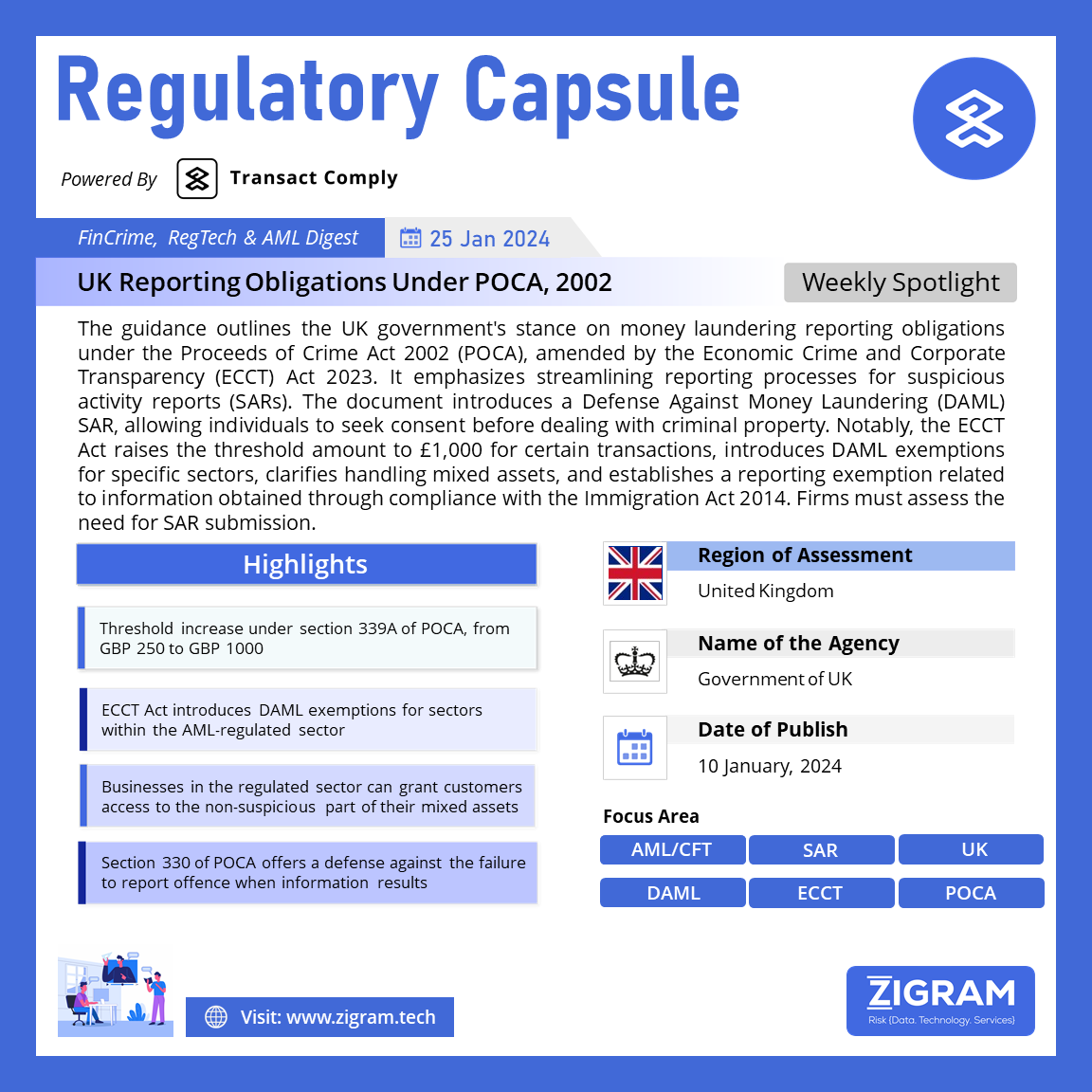Published Date:
This week we discuss the Reporting Obligations under the Proceeds of Crime Act, 2002.
The guidance outlines the UK government’s stance on money laundering reporting obligations within the framework of the Proceeds of Crime Act 2002 (POCA), as amended by the Economic Crime and Corporate Transparency (ECCT) Act 2023. Following Royal Assent, the purpose is to provide a comprehensive understanding of the reporting landscape, emphasizing the need for reporters to apply the guidance effectively to streamline their reporting processes and enhance the overall effectiveness of the suspicious activity reports (SARs) regime.
Background:
Under sections 327-329 of POCA, individuals may face liability for principal money laundering offences when dealing with criminal property. However, the guidance introduces a mechanism to avoid these offences by submitting an authorized disclosure known as a Defence Against Money Laundering (DAML) SAR to the National Crime Agency (NCA) and obtaining consent or deemed consent to proceed.
On January 5, 2023, the threshold amount specified in section 339A of POCA saw a substantial increase from £250 to £1,000 for acts related to the operation of an account, such as mortgage payments, with a bank or similar firm. Notably, this threshold does not apply to actions like returning funds when terminating a customer relationship. This threshold amount signifies the value of criminal property below which a bank or similar firm can conduct a transaction without submitting a DAML and without committing a main money laundering offence under POCA.
Reporting Exemptions by ECCT Act:
The ECCT Act introduces several DAML exemptions, augmenting the reporting landscape:
1. AML Regulated Sector Exemption: Beyond the threshold exemption, the ECCT Act extends DAML exemptions to the entire Anti-Money Laundering (AML) regulated sector, encompassing legal, accountancy, and casino sectors. This exemption applies when ending a customer relationship and transferring property valued below £1,000, subject to compliance with existing customer due diligence duties.
2. Handling of Mixed Assets: The ECCT Act clarifies the treatment of mixed assets, enabling businesses to grant customers proportionate access to the non-suspicious portion of their assets. This exemption provides flexibility when only part of the assets is suspected to be involved in criminal activity.
3. Transaction-Specific Limitations: While exemptions can apply to the same account or customer, they cannot be utilized within the same transaction. The mixed-property exemption requires firms to retain at least the value of assets related to suspicion, and the exit and pay-away exemption is applicable only during relationship termination. The mixed-property exemption operates in parallel to the threshold exemption for transactions below the specified amount in section 339A.
4. Reporting Exemption: Under section 330 of POCA, the ECCT Act introduces a reporting exemption providing a defence against the offence of failure to report. This applies when information comes to reporters through a “status check” or “immigration check” carried out in compliance with the Immigration Act 2014.
Combined Impact of Exemptions:
Firms are advised to assess the necessity of submitting a SAR under section 330 of POCA in each case. The exemptions collectively influence how firms handle situations involving concealing, disguising, converting, transferring, or removing criminal property, as defined in sections 327, 328, and 329 of POCA.
In conclusion, the guidance and amendments brought forth by the ECCT Act signify a comprehensive effort to refine and enhance the money laundering reporting framework, providing clarity on thresholds, exemptions, and reporting obligations. Firms operating in regulated sectors must carefully navigate these guidelines to ensure compliance and contribute to the broader effectiveness of the SARs regime.
- #MoneyLaunderingGuidance
- #ECCTAct2023
- #SARsRegime
- #AMLCompliance
- #FinancialSecurity
- #ReportingExemptions
- #POCAUpdates
- #UnitedKingdom

